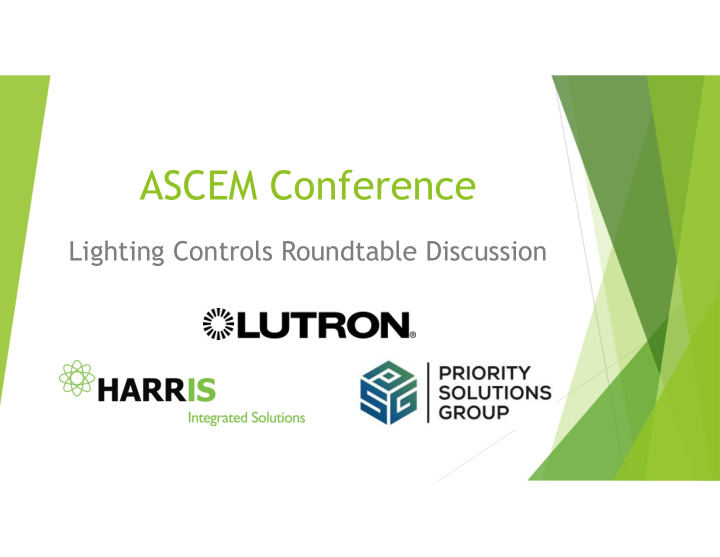



ASCEM Conference Lighting Controls Roundtable Discussion
Why do we want lighting controls? Behavior Modification versus lighting controls Implementation and outcomes Typical Controls Keyed Switches Dual switching Standalone occupancy sensors
Additional lighting control strategies Dimming Grouping Daylight harvesting IoT and system networking High End Trim Energy reporting Scheduling Diagnostics reporting Demand Response
Wired Solutions PROS CONS Out-of-box functionality High labor cost in retrofit applications Distance only limited by Limited functionality max wire run Difficult to modify settings after installation
Wireless Solutions Multiple options for wireless communication Radio Frequency Bluetooth WiFi In standalone systems, connection to internet not necessary
Wireless Network Architectures 1) Fixed Networks 2) Mesh Networks • Dedicated sending, receiving, and • System devices form a “matrix” of computing stations provide RF possible message delivery routes coverage • Messages can be relayed through any • Messages move through the network system device in a predetermined manner producing • Assuming enough system devices, no short delivery times repeaters are required (potentially lower • Location of source and destination cost) device do not affect performance • Covers further distance • Distance is limited by number of repeaters
Wireless Solutions PROS CONS Lower labor cost in retrofit applications Commissioning required for devices to communicate Great for areas with asbestos or lead Limited distance for communication Can be used in historical buildings Increased functionality Ease of setting customization post-install
Networked Solutions Pros Integration with building controls Data utilization Remote system monitoring Highest energy savings Cons Highest material cost Requires IT department Wired or Wireless Systems
Analysis of Options New Fixtures – No Controls New Fixtures with Integrated Controls New fixtures with Networked Controls
Analysis of Options
Integration with other Building Controls Most common protocol for integrating HVAC and lighting systems How do they communicate? Useful points Light levels Peak demand monitoring Schedules Occupancy data Historical energy data
What are the best locations? Best Practices – Where to place in the room? Occupancy Sensing Room sensor versus fixture sensor
Use multiple daylight rows Best Practice Do not implement daylighting on – Daylight a switching system! Harvesting Dim to minimum light level instead of off
Why use lighting controls? On top of saving energy, lighting controls also: Improve occupant comfort Improve productivity Allow the use of the building to change over time
Recommend
More recommend